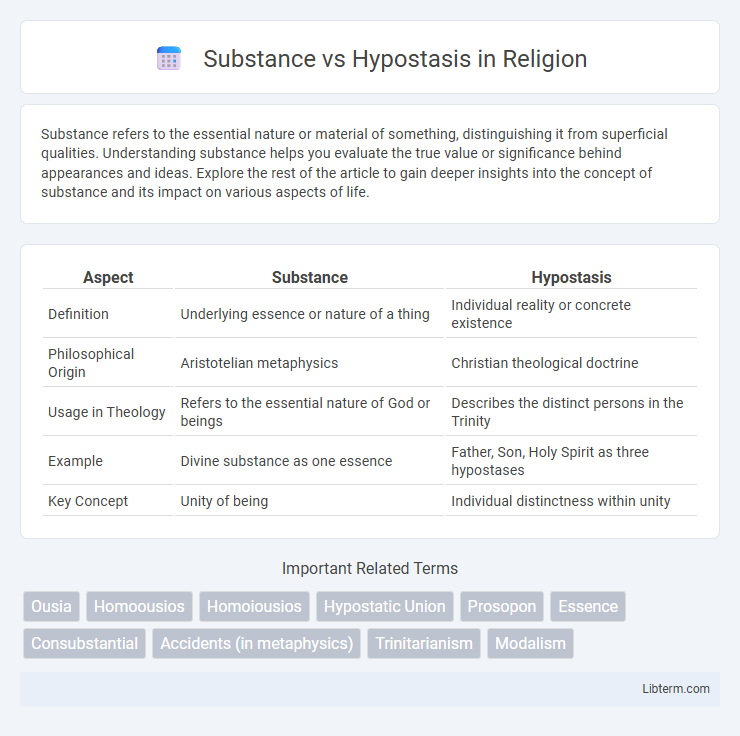Substance refers to the essential nature or material of something, distinguishing it from superficial qualities. Understanding substance helps you evaluate the true value or significance behind appearances and ideas. Explore the rest of the article to gain deeper insights into the concept of substance and its impact on various aspects of life.
Table of Comparison
| Aspect | Substance | Hypostasis |
|---|---|---|
| Definition | Underlying essence or nature of a thing | Individual reality or concrete existence |
| Philosophical Origin | Aristotelian metaphysics | Christian theological doctrine |
| Usage in Theology | Refers to the essential nature of God or beings | Describes the distinct persons in the Trinity |
| Example | Divine substance as one essence | Father, Son, Holy Spirit as three hypostases |
| Key Concept | Unity of being | Individual distinctness within unity |
Defining Substance and Hypostasis
Substance refers to the fundamental essence or material reality that underlies and sustains the existence of things, often characterized by attributes and properties. Hypostasis, particularly in theological and philosophical contexts, denotes the concrete individual reality or underlying entity that manifests specific attributes, especially used to describe distinct persons in the Holy Trinity. Defining substance emphasizes its role as the universal foundation of existence, while hypostasis highlights the distinct individuality and personal reality within that substance.
Etymology and Historical Origins
The term "substance" originates from the Latin "substantia," meaning "that which stands under," reflecting its philosophical use to denote the underlying essence of a thing. "Hypostasis," derived from the Greek upostasis (hupostasis), translates as "that which stands under" or "foundation," historically used in ancient Greek philosophy and early Christian theology to describe the underlying reality or personhood. Both terms evolved through Aristotelian and Patristic thought, where "substance" emphasized the essential nature of entities, while "hypostasis" came to articulate distinct persons in the Trinity, illustrating their nuanced semantic and doctrinal roles.
Substance in Ancient Philosophy
In Ancient Philosophy, substance is considered the essential reality underlying all phenomena, representing what exists independently and serves as the fundamental entity in metaphysics. Philosophers such as Aristotle defined substance as that which is neither predicable of a subject nor present in a subject, distinguishing it from accidental properties. Substance forms the basis for understanding identity and change, forming a core concept in the study of being (ontology) within classical Greek thought.
Hypostasis: Evolving Meanings
Hypostasis, originally rooted in ancient Greek philosophy as the underlying reality or essence of a thing, evolved to signify distinct individual existence within Christian theological contexts, particularly in the doctrine of the Trinity where it denotes the three distinct persons of God sharing one substance. This shift from a metaphysical principle to a relational and personal identity highlights hypostasis as an entity characterized by unique personhood, as opposed to substance, which refers to the common essence. The nuanced development of hypostasis underscores its critical role in differentiating personal identities while maintaining ontological unity in complex theological and philosophical frameworks.
Substance vs Hypostasis in Christian Theology
In Christian theology, substance refers to the essential nature or essence of a being, while hypostasis denotes the individual reality or personhood within that essence. The distinction is crucial in Trinitarian doctrine, where the Father, Son, and Holy Spirit share one substance (ousia) but exist as three distinct hypostases, affirming unity without confusion. This theological concept safeguards the understanding of God as one essence in three persons, central to orthodox Christianity.
Ontological Implications
Substance refers to the fundamental essence that exists independently and underlies properties, while hypostasis denotes the concrete individual instance of that substance, particularly in theological contexts such as the Trinity. Ontologically, substance embodies the universal, unchanging reality, whereas hypostasis represents distinct personhood or individuality within that substance. Understanding their distinction is crucial for metaphysical discussions on existence, identity, and the nature of being.
Substance and Hypostasis in Modern Philosophy
In modern philosophy, substance refers to the fundamental essence or underlying reality that exists independently and possesses properties, while hypostasis is often treated as a specific manifestation or instance of substance that individualizes and concretizes it. Substance serves as the ontological foundation, providing continuity and identity across potential changes, whereas hypostasis delineates distinct, concrete expressions within that substance. Philosophers like Spinoza and Heidegger explore substance as a monistic existence or as Being itself, contrasting with hypostasis, which marks particular, individualized beings within the broader ontological framework.
Key Thinkers on Substance and Hypostasis
Aristotle introduced the concept of substance as the fundamental reality underlying change, emphasizing its permanence and individuation in his Metaphysics. Plotinus expanded on hypostasis, defining it as the three primary realities--The One, the Intellect, and the Soul--each representing different levels of existence in Neoplatonism. Thomas Aquinas synthesized Aristotelian substance with Christian theology, interpreting substance as essence and hypostasis as the individual reality of a nature, especially in the doctrine of the Trinity.
Comparative Analysis: Similarities and Differences
Substance and hypostasis both denote fundamental entities in metaphysics, often used to describe the underlying reality that supports properties or attributes. Substance typically refers to an independent, self-sustaining entity, such as a physical object or essence, while hypostasis, especially in theological contexts like the Trinity, signifies a distinct person or reality within a unified existence. Despite their differences, both terms emphasize ontological priority and serve as key concepts in understanding identity and existence across philosophical and theological frameworks.
Contemporary Relevance and Debates
Contemporary debates on substance versus hypostasis center on their distinct roles in metaphysics and theology, particularly within Christian Trinitarian doctrine where hypostasis refers to individual persons of the Godhead, and substance indicates the shared divine essence. Philosophers and theologians engage with these concepts to clarify identity, individuality, and unity in complex entities, influencing discussions in ontology and personal identity theory. Advances in analytic philosophy and modern theological interpretations continue to refine the understanding of substance and hypostasis in relation to consciousness, existence, and relational properties.
Substance Infographic

 libterm.com
libterm.com